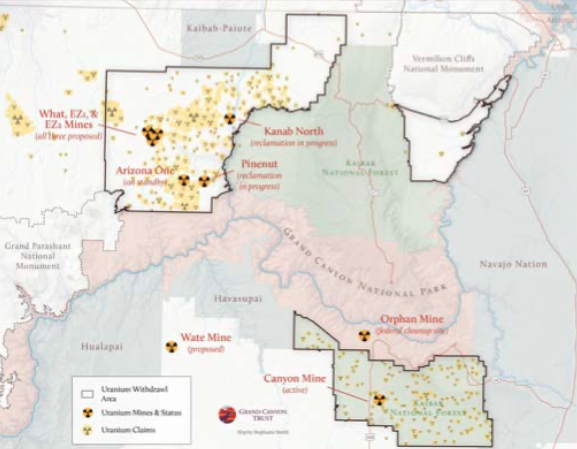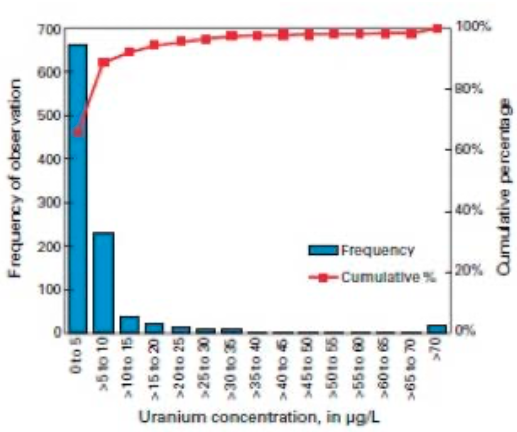Executive summary: The United States consumes 27,500 tons of uranium per year, far exceeding the 1,750 to 2,250 tons that are mined in the U.S. annually. While uranium ore is prevalent in the South West, concentrated in collapsed breccia pipes throughout the Grand Canyon, the environmental and health effects of mining uranium ore in the region could pose dramatic problems for the surrounding habitat and communities, including uranium contamination to surrounding environments and wildlife populations. Still, 3,000 uranium claims have been made in the Northern Arizona region and uranium mining continues to occur near the Grand Canyon. The “Uranium mining in Northern Arizona: Mineral rights, land use, and public policy” report by Emily Houlihan is a call to action for policymakers and environmental advocacy groups to protect the surrounding environment of the Grand Canyon by increasing research in the environmental and health impacts of uranium mining in Northern Arizona.

Context and importance of problem: Uranium is the fuel most commonly used by nuclear power plants for nuclear fission, which is used to produce energy (U.S. Energy Information Administration). In the U.S., about 20% of the energy used is generated from nuclear power plants. While nuclear power is considered to be a clean energy source, the process of mining uranium has many known environmental and health hazards associated with it. Environmental hazards of mining uranium include waste rock, dusts, in situ uranium ore distributed by mining, and the dispersal of contaminants (including radioactive materials and heavy metals) by floods, wind, and groundwater circulation. The mines themselves are also radioactive and toxic to miners, tourists, and animals. Health hazards of mining uranium include contaminated drinking water, exposure to toxins on site (i.e. abandoned mines), and consuming tainted food (i.e. wildlife exposed to toxins).
Under the General Mining Act of 1872, uranium miners were allowed to claim federal land for uranium mining rights for only $5 dollars an acre, resulting in 3,000 uranium claims being made in the Northern Arizona region. In an effort to slow the extraction of uranium and prevent environmental damage in the region, the House Natural Resources Committee blocked uranium mining claims near the Grand Canyon in 2008, preventing new mines from being developed. Subsequently in 2009, a 2 year moratorium on uranium mining claims was issued to assess the environmental impacts of uranium mining (2010 U.S. Geological Survey Special Investigation). From 2010 through 2012, the U.S. Geological Survey (USGS) conducted an investigation focusing on the availability of uranium in the Northern Arizona breccia pipes, the impact on wildlife, the impact on hydrologic systems, and the impact of mines that are already in existence.
The 2010 USGS Special Investigation identified several water sources contaminated with lead, arsenic, mercury, molybdenum, and uranium in concentrations higher than the Environmental Protection Agency’s (EPA) maximum contaminant level (MCL) threshold standards. The MCL for uranium is 30 micrograms per liter (ug/l). The Special Investigation identified several water sources where the concentration of uranium in water was higher that 30 ug/l, and multiple sites where the concentration was above 70 ug/l, with one spring identified as having a concentration of 400 ug/l of uranium. Additionally, the Special Investigation identified multiple sources of contamination to biological pathways of mammals, birds, reptiles, invertebrates, fish, amphibians, plants, and soils. The biological pathways were disrupted through contaminant exposure via soils, groundwater, and sediments.

The findings of the 2010 USGS Special Investigation indicated that uranium mining had the potential to influence the surrounding environment, and therefore concluded that more monitoring is needed to determine the true and long-term effects of mining on biology, groundwater resources,
and communities in Northern Arizona. While this conclusion led Ken Salazar, the former secretary of the interior, to withdraw uranium mining for 1.7 million acres near the Grand Canyon, blocking any new uranium claims for 20 years, the Trump administration has since reopened uranium mines near the Grand Canyon. Currently, uranium mining continues near the Grand Canyon, and the long term impact remains unknown.
Policy recommendations: The 2010 USGS Special Investigation on uranium mining in Northern Arizona identified several water sources contaminated with uranium and heavy metals, and several biological pathways at risk of contamination from toxins released during mining. Because the Special Investigation was only conducted for 2 years, it was unable to assess the long term effects of uranium mining in the region, however long term effects are likely to exist due to the sources of contamination identified during the investigation. To prevent further contamination and potential exposure to toxic materials in the Grand Canyon region, a long term investigation of the environmental impacts of uranium mining should be conducted before allowing mining to continue.
